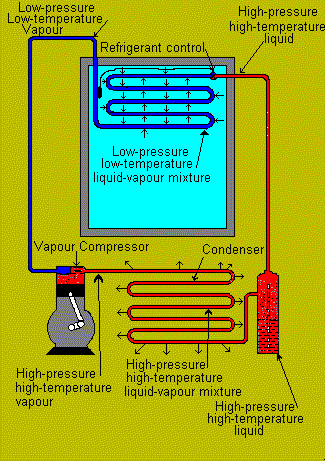|
|
|
REFRIGERATION
SYSTEMS
|

|
Alongside
is a simplified animation of the vapour compression refrigeration
process which common to most refrigeration systems.
In response
to a sensor (usually temperature) the process begins.
- Refrigerant vapour in
the COMPRESSOR is compressed, causing a rise in it's
temperature approximately 10 degrees celsius above outside
ambient. The High-pressure High-temperature vapour flows
into the
- CONDENSER. The refrigerant
vapour, being hotter than it's surroundings gives up
it's heat . The vapour condenses and becomes a liquid.
- Liquid refrigerant is
stored in the RECEIVER as a reservoir before being metered
into the evaporator by a flow expansion device.
- The refrigerant liquid
expands resulting in a fall in temperature to approximately
10 degrees celsius below process requirements, and flows
into
- The EVAPORATOR. Here the
low temperature liquid absorbs heat from the surroundings
and evaporates (boils) becoming a liquid-vapour mixture
at low temperature, evaporating totally before returning
to the COMPRESSOR to begin the cycle again.
|
This is the most common method used
in the refrigeration systems process. You will find it in use
in applications from giant refrigerated storage facilities to
food display counters in the your local deli; from air conditioning
NASA Mission Control Centre to a high street shop. There's a
good chance that your domestic refrigerator runs it this way
too.
|
|
|